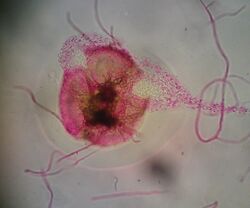Biology:Pycnidium
From HandWiki
Short description: Fungal spore-bearing structure
A pycnidium (plural pycnidia) is an asexual fruiting body produced by mitosporic fungi, for instance in the order Sphaeropsidales (Deuteromycota, Coelomycetes) or order Pleosporales (Ascomycota, Dothideomycetes). It is often spherical or inversely pearshaped (obpyriform) and its internal cavity is lined with conidiophores. When ripe, an opening generally appears at the top, through which the pycnidiospores escape.[1][2][3]
References
- ↑ Punithalingam, E. (1966). "Development of the pycnidium in Septoria". Transactions of the British Mycological Society 49 (1): 19–25. doi:10.1016/S0007-1536(66)80030-X. ISSN 0007-1536.
- ↑ Roger, C.; Tivoli, B. (1996). "Spatio-temporal development of pycnidia and perithecia and dissemination of spores of Mycosphaerella pinodes on pea (Pisum sativum)". Plant Pathology 45 (3): 518–528. doi:10.1046/j.1365-3059.1996.d01-139.x. ISSN 0032-0862.
- ↑ Ariyawansa, Hiran A.; Phillips, Alan J.L.; Chuang, Wei-Yu; Tsai, Ichen (2018-07-26). "Tzeananiaceae, a new pleosporalean family associated with Ophiocordyceps macroacicularis fruiting bodies in Taiwan". MycoKeys 37 (37): 1–17. doi:10.3897/mycokeys.37.27265. ISSN 1314-4049. PMID 30100794.
Further reading
- Kulik, Martin M. "Symptomless infection, persistence, and production of pycnidia in host and non-host plants by Phomopsis batatae, Phomopsis phaseoli, and Phomopsis sojae, and the taxonomic implications." Mycologia(1984): 274–291.
- Calpouzos, L., and D. B. Lapis. "Effects of light on pycnidium formation, sporulation, and tropism by Septoria nodorum." Phytopathology 60.5 (1970): 791–794.
 |


